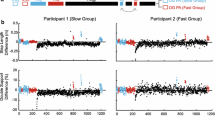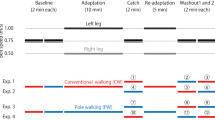Abstract
Animal studies demonstrate that the neural mechanisms underlying locomotion are specific to the modes and/or speeds of locomotion. In line with animal results, human locomotor adaptation studies, particularly those focusing on walking, have revealed limited transfers of adaptation among movement contexts including different locomotion speeds. Running is another common gait that humans utilize in their daily lives and is distinct from walking in terms of the underlying neural mechanisms. The present study employed an adaptation paradigm on a split-belt treadmill to examine the possible independence of neural mechanisms mediating different running speeds. The adaptations learned with split-belt running resulted in aftereffects with magnitudes that varied in a speed-dependent matter. In the two components of the ground reaction force investigated, the anterior braking and posterior propulsive components exhibited different trends. The anterior braking component tended to show larger aftereffect under speeds near the slower side speed of the previously experienced split-belt in contrast to the posterior propulsive component in which the aftereffect size tended to be the largest at a speed that corresponded to the faster side speed of the split-belt. These results show that the neural mechanisms underlying different running speeds in humans may be independent, just as in human walking and animal studies.






Similar content being viewed by others
References
Arshavsky YI, Gelfand IM, Orlovsky GN, Pavlova GA (1978) Messages conveyed by spinocerebellar pathways during scratching in the cat. II. Activity of neurons of the ventral spinocerebellar tract. Brain Res 151(3):493–506
Berger DJ, Gentner R, Edmunds T, Pai DK, d’Avella A (2013) Differences in adaptation rates after virtual surgeries provide direct evidence for modularity. J Neurosci 33(30):12384–12394
Blickhan R (1989) The spring-mass model for running and hopping. J Biomech 22(11–12):1217–1227
Bosco G, Rankin A, Poppele R (1996) Representation of passive hindlimb postures in cat spinocerebellar activity. J Neurophysiol 76(2):715–726
Bosco G, Poppele RE, Eian J (2000) Reference frames for spinal proprioception: limb endpoint based or joint-level based? J Neurophysiol 83(5):2931–2945
Cappellini G, Ivanenko YP, Poppele RE, Lacquaniti F (2006) Motor patterns in human walking and running. J Neurophysiol 95(6):3426–3437
Cavagna GA, Heglund NC, Taylor CR (1977) Mechanical work in terrestrial locomotion: two basic mechanisms for minimizing energy expenditure. Am J Physiol 233(5):R243-261
Choi JT, Bastian AJ (2007) Adaptation reveals independent control networks for human walking. Nat Neurosci 10:1055–1062
Earhart GM, Fletcher WA, Horak FB, Block EW, Weber KD, Suchowersky O, Melvill Jones G (2002) Does the cerebellum play a role in podokinetic adaptation? Exp Brain Res 146(4):538–542
Fedirchuk B, Stecina K, Kristensen KK, Zhang M, Meehan CF, Bennett DJ, Hultborn H (2013) Rhythmic activity of feline dorsal and ventral spinocerebellar tract neurons during fictive motor actions. J Neurophysiol 109(2):375–388
Hamzey RJ, Kirk EM, Vasudevan EV (2016) Gait speed influences aftereffect size following locomotor adaptation, but only in certain environments. Exp Brain Res 234(6):1479–1490
Hodgson JA, Roy RR, De Leon R, Dobkin B, Edgerton VR (1994) Can the mammalian spinal cord learn a motor task? Med Sci Sports Exerc 26:1491–1497
Jayaram G, Galea JM, Bastian AJ, Celnik P (2011) Human locomotor adaptive learning is proportional to depression of cerebellar excitability. Cereb Cortex 21(8):1901–1909
Jayaram G, Tang B, Pallegadda R, Vasudevan EV, Celnik P, Bastian A (2012) Modulating locomotor adaptation with cerebellar stimulation. J Neurophysiol 107(11):2950–2957
Lam T, Wolstenholme C, Yang JF (2003) How do infants adapt to loading of the limb during the swing phase of stepping? J Neurophysiol 89:1920–1928
MacKay-Lyons M (2002) Central pattern generation of locomotion: a review of the evidence. Phys Ther 82(1):69–83
Mawase F, Haizler T, Bar-Haim S, Karniel A (2013) Kinetic adaptation during locomotion on a split-belt treadmill. J Neurophysiol 109(8):2216–2227
McLean DL, Masino MA, Koh IYY, Lindquist WB, Fetcho JR (2008) Continuous shifts in the active set of spinal interneurons during changes in locomotor speed. Nat Neurosci 11:1419–1429
Morton SM, Bastian AJ (2006) Cerebellar contributions to locomotor adaptations during splitbelt treadmill walking. J Neurosci 26(36):9107–9116
Musselman KE, Patrick SK, Vasudevan EV, Bastian AJ, Yang JF (2011) Unique characteristics of motor adaptation during walking in young children. J Neurophysiol 105(5):2195–2203
Nilsson J, Thorstensson A (1987) Adaptability in frequency and amplitude of leg movements during human locomotion at different speeds. Acta Physiol Scand 129(1):107–114
Nilsson J, Thorstensson A (1989) Ground reaction forces at different speeds of human walking and running. Acta Physiol Scand 136(2):217–227
Ogawa T, Kawashima N, Ogata T, Nakazawa K (2012) Limited transfer of newly acquired movement patterns across walking and running in humans. PLoS One 7(9):e46349
Ogawa T, Kawashima N, Ogata T, Nakazawa K (2014) Predictive control of ankle stiffness at heel contact is a key element of locomotor adaptation during split-belt treadmill walking in humans. J Neurophysiol 111(4):722–732
Ogawa T, Kawashima N, Obata H, Kanosue K, Nakazawa K (2015) Mode-dependent control of human walking and running as revealed by split-belt locomotor adaptation. J Exp Biol 218:3192–3198
Prilutsky BI, Gregor RJ (2001) Swing- and support-related muscle actions differently trigger human walk-run and run walk transitions. J Exp Biol 204:2277–2287
Reisman DS, Block HJ, Bastian AJ (2005) Interlimb coordination during locomotion: what can be adapted and stored? J Neurophysiol 94:2403–2415
Reisman DS, Wityk R, Silver K, Bastian AJ (2009) Split-belt treadmill adaptation transfers to overground walking in persons poststroke. Neurorehabil Neural Repair 23(7):735–744
Shik ML, Severin FV, Orlovsky GN (1966) Control of walking and running by means of electrical stimulation of the mid-brain. Biophys 11:756–765
Statton MA, Toliver A, Bastian AJ (2016) A dual-learning paradigm can simultaneously train multiple characteristics of walking. J Neurophysiol 115(5):2692–2700
Steeves JD, Sholomenko GN, Webster DM (1987) Stimulation of the pontomedullary reticular formation initiates locomotion in decerebrate birds. Brain Res 401(2):205–212
Sterman MB, Fairchild MD (1966) Modification of locomotor performance by reticular formation and basal forebrain stimulation in the cat: evidence for reciprocal systems. Brain Res 2(3):205–217
Talpalar AE, Bouvier J, Borgius L, Fortin G, Pierani A, Kiehn O (2013) Dual-mode operation of neuronal networks involved in left-right alternation. Nature 500(7460):85–88
Vasudevan EV, Bastian AJ (2010) Split-belt treadmill adaptation shows different functional networks for fast and slow human walking. J Neurophysiol 103(1):183–191
Yanagihara D, Kondo I (1996) Nitric oxide plays a key role in adaptive control of locomotion in cat. Proc Natl Acad Sci U S A 93:13292–13297
Yokoyama H, Ogawa T, Kawashima N, Shinya M, Nakazawa K (2016) Distinct sets of locomotor modules control the speed and modes of human locomotion. Sci Rep 6:36275
Yokoyama H, Ogawa T, Shinya M, Kawashima N, Nakazawa K (2017) Speed dependency in α-motoneuron activity and locomotor modules in human locomotion: indirect evidence for phylogenetically conserved spinal circuits. Proc R Soc B 284:20170290
Funding
This work was supported by the Yamaha Motor Foundation for Sports and Grant-in-Aid for Young Scientists (B) (#16K16515) from Japan Society for the Promotion of Science (JSPS) to T.O.
Author information
Authors and Affiliations
Contributions
T.O. performed experiments; T.O. analyzed data; T.O., H.O., H.Y., N.K., and K.N. interpreted results; T.O. prepared the figures; T.O. drafted the manuscript; T.O., H.O., H.Y., N.K., and K.N. research conception and design; T.O., H.O., H.Y., N.K., and K.N. approved the final manuscript.
Corresponding author
Ethics declarations
Conflict of interest
The authors have declared that no competing interests exist.
Electronic supplementary material
Rights and permissions
About this article
Cite this article
Ogawa, T., Obata, H., Yokoyama, H. et al. Velocity-dependent transfer of adaptation in human running as revealed by split-belt treadmill adaptation. Exp Brain Res 236, 1019–1029 (2018). https://doi.org/10.1007/s00221-018-5195-5
Received:
Accepted:
Published:
Issue Date:
DOI: https://doi.org/10.1007/s00221-018-5195-5





